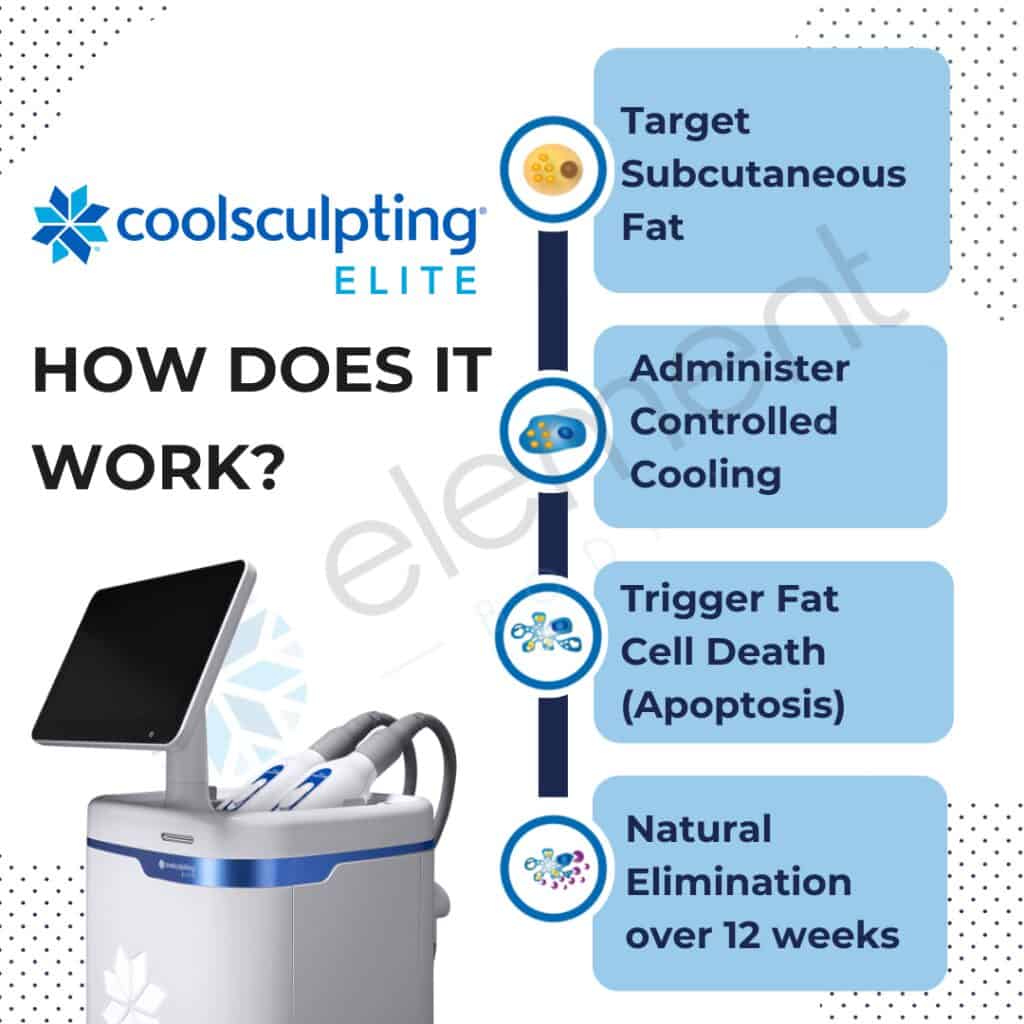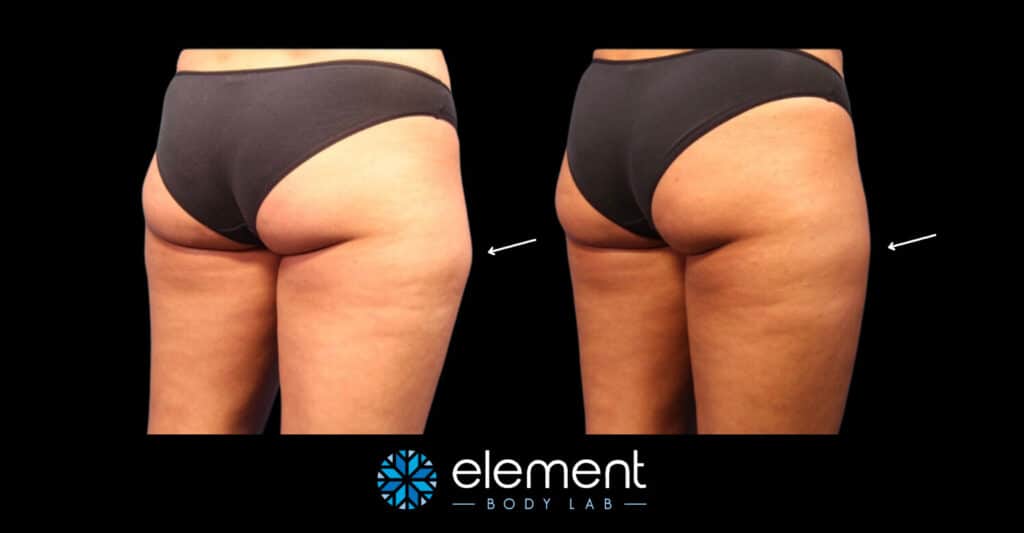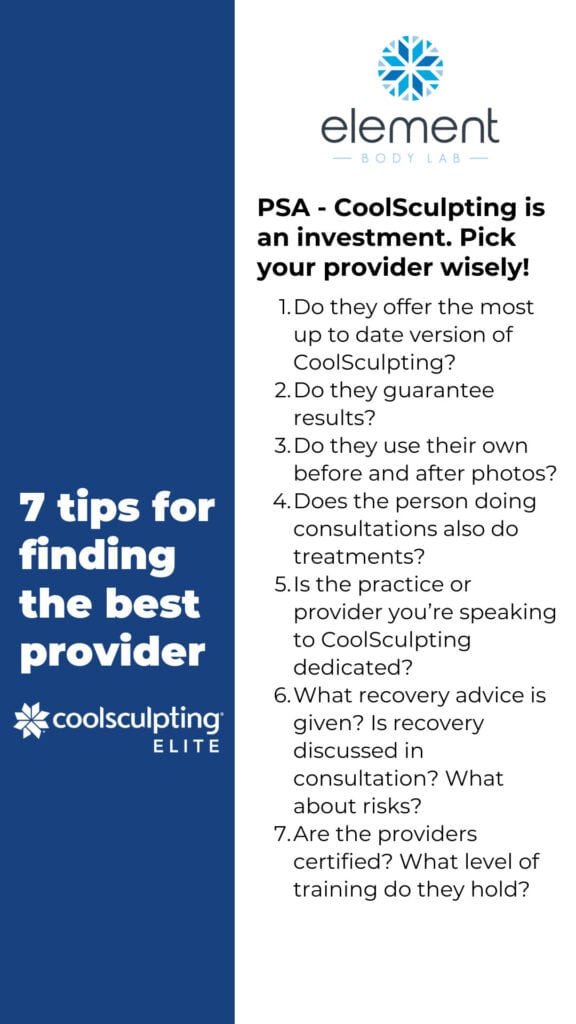Does CoolSculpting Get Rid of Cellulite?
Cellulite is a common concern for many clients at Element Body Lab. It appears as dimpled, uneven skin on areas like the thighs, buttocks, and abdomen. While completely harmless, its appearance can be a source of frustration for those seeking smoother skin. So, can CoolSculpting help with cellulite? The answer varies—it works for some but not for others, depending on the unique structures of your anatomy. To help you determine if it’s the right solution for you, we’ll explore the facts, debunk common myths, and share tips to boost your confidence in your skin.
What Causes Cellulite?
- Fibrous bands: Tight bands under the skin pull down, causing dimpling.
- Fat deposits: Fat pushing against the skin worsens the effect.
- Genetics: Some people are more prone to cellulite based on their body type.
- Lifestyle factors: Diet, exercise, and hydration impact skin and fat appearance.
Did you know? Over 90% of women experience cellulite, regardless of weight or fitness level.
What Does CoolSculpting Do to Fat?
CoolSculpting uses cryolipolysis, a process that freezes fat cells, causing them to die and be naturally eliminated by the body. Note: it targets fat, but not the fibrous bands that are the main contributing factor to cellulite. Here’s what makes CoolSculpting unique:
- Targets stubborn fat: Specifically designed for areas resistant to diet and exercise.
- Permanent fat reduction: Once fat cells are gone, they don’t come back.
- Non-surgical: No downtime or invasive procedures required.
What happens after treatment? Your body processes and eliminates the treated fat cells over 1-3 months, revealing a more sculpted you.

Learn more about CoolSculpting Elite.
Why Doesn’t CoolSculpting Fix Cellulite Directly?
Keep in mind, cellulite is caused by fibrous bands pulling down on the skin, not just by excess fat. While CoolSculpting reduces fat, it doesn’t address the fibrous bands or skin texture. For some, reducing fat can improve the look of cellulite. For others, it might have little to no effect. That’s why it’s important to set realistic expectations and explore all your options. Learn more about CoolSculpting Elite.
Our team offers virtual consultations to give you our expert opinion in a convenient video call. Book a consultation to chat with us one on one.
How Long Do CoolSculpting Results Last?
Unlike most cellulite treatments, wich are temporary, CoolSculpting results are long-lasting because treated fat cells are permanently removed. However, maintaining a healthy lifestyle is key to keeping your results.
Here’s a typical timeline:
- Weeks 1-4: Initial changes may start to appear.
- Weeks 4-8: Noticeable fat reduction in treated areas.
- Months 2-3: Full results become visible as your body processes the dead fat cells.
- Results are permanent. Once the fat is gone, it’s gone for good. Learn more about CoolSculpting Elite.
Combination Therapy for Cellulite and Fat Reduction
CoolSculpting can be even more effective when combined with treatments designed for cellulite. Here’s how they work together:
- Cellfina: Breaks fibrous bands causing dimpling.
- Radiofrequency (RF) Treatments: Tightens skin and smooths texture.
- CoolSculpting: Reduces fat volume for enhanced contours.
A personalized treatment plan that includes multiple therapies can give you the best results. Learn more about CoolSculpting Elite.
CoolSculpting and Cellulite on the Thighs
CoolSculpting is a fat-freezing treatment designed to target and eliminate fat cells. While it reshapes areas like the thighs, it doesn’t directly treat the fibrous bands that cause cellulite.
For some clients, reducing fat can improve the look of cellulite. For others, the results might not meet their expectations. That’s why consulting with a highly trained provider, like the experts at Element Body Lab, is key. We’ll give you honest feedback and help you understand what CoolSculpting can and cannot do. Learn more about CoolSculpting Elite.
This before and after photo showcases exceptional CoolSculpting results. Notably, the texture of the fat in her legs is markedly improved and it appears as if the cellulite has vanished from her thighs. By removing the excess fat deposits, her skin was able to improve in texture.

Alternatively, this client had her outer thighs treated as well. She has cellulite before CoolSculpting, and she has cellulite after CoolSculpting, even though the shape of her thigh is much different.

Does Fat Freezing Work on Cellulite?
Fat freezing (cryolipolysis) works well for stubborn fat reduction, but it doesn’t target cellulite’s root cause. Here’s how it helps:
- Reduces fat volume: Less fat can make dimpling less noticeable.
- Improves body contours: Creates a smoother, more sculpted look.
But it’s not guaranteed to improve cellulite. That’s why combining CoolSculpting with other treatments often gives the best results. Learn more about CoolSculpting Elite.
Everyday Habits to Reduce Cellulite Naturally
While professional treatments can help, everyday habits make a difference too:
- Stay hydrated: Improves skin elasticity and flushes toxins.
- Eat a healthy diet: Focus on collagen-rich foods and healthy fats.
- Strength training: Builds muscle tone and reduces fat.
- Dry brushing: Stimulates circulation and exfoliates skin.
- Manage stress: Chronic stress can weaken collagen and worsen cellulite.
Is CoolSculpting Worth It if I Have Cellulite?
CoolSculpting is worth it if you’re looking to reduce fat in specific areas, but it’s not a cellulite cure. Here’s who benefits most:
- People who want to target stubborn fat.
- Those combining treatments like RF or Cellfina for cellulite.
- Clients who understand the difference between fat reduction and skin tightening.
How Do You Break Up Cellulite on Your Thighs?
Cellulite doesn’t have a one-size-fits-all fix, but here are effective options:
- Massage therapies: Boost circulation and reduce fluid buildup.
- Laser or RF treatments: Break up fibrous bands and tighten skin.
- Exercise: Strengthens muscles and reduces fat.
- Topical creams: Look for ingredients like caffeine or retinol.
CoolSculpting can complement these methods by reducing fat in targeted areas. Want more ideas? Check out our blog about cellulite remedies. Or learn more about CoolSculpting Elite.
Common Misconceptions About CoolSculpting and Cellulite
- Myth: CoolSculpting cures cellulite.
- Truth: It’s a fat reduction treatment, not a cellulite treatment.
- Myth: All fat freezing results are the same.
- Truth: Provider expertise matters! Trained specialists like ours deliver better results.
Learn more about CoolSculpting Elite.
CoolSculpting vs. Other Treatments for Cellulite
- CoolSculpting: Reduces fat volume for improved contours.
- Cellfina: Breaks fibrous bands to reduce dimpling.
- Laser and RF Therapy: Tightens skin and improves texture.
Combining these treatments often provides the best results for cellulite concerns.
Do Cold Plunges or Cryotherapy Reduce Cellulite?
Cold plunges and cryotherapy are trendy for boosting circulation and tightening skin. While they may provide temporary improvement, they don’t eliminate cellulite or fat. CoolSculpting, however, offers long-term fat reduction that can enhance body contours.
Expert Tips from Element Body Lab
- Consult a provider who specializes in CoolSculpting for personalized advice.
- Combine treatments to address fat reduction and cellulite.
- Follow aftercare instructions to maximize your results.
- Maintain a healthy lifestyle for lasting improvements.

How to Choose the Right CoolSculpting Provider
Here’s what to look for:
- Expertise: Choose a provider specializing in CoolSculpting.
- Technology: Look for the latest equipment, like CoolSculpting Elite.
- Results: Check reviews, testimonials, and before/after photos.
At Element Body Lab, we check all these boxes and more!

Why Trust Element Body Lab?
Here’s why we’re Dallas’s #1 CoolSculpting provider:
- Exclusive focus on CoolSculpting: It’s all we do, and we do it well.
- Highly trained team: Led by a national trainer on CoolSculpting technology.
- Latest technology: We use CoolSculpting Elite for faster, more effective treatments.
- Personalized care: We customize every plan to your body and goals.
Ready to Explore Your Options?
Schedule a consultation with Element Body Lab to learn if CoolSculpting is right for you. We’ll help you create a plan that fits your needs and delivers results you’ll love. Learn more about CoolSculpting Elite.
Want to see real results? Check out our CoolSculpting Before & After Photos.
